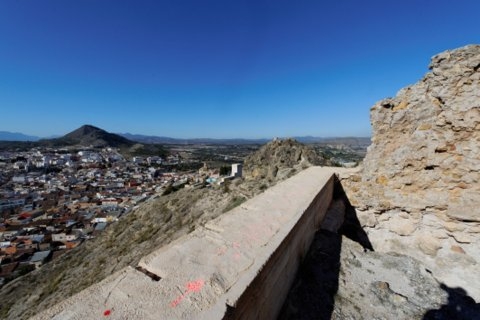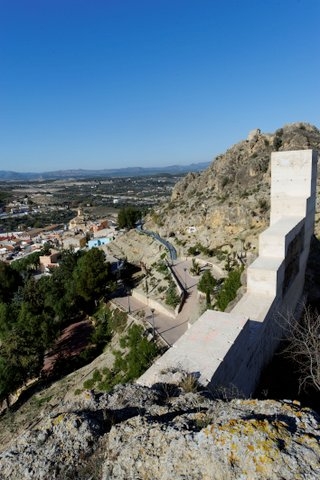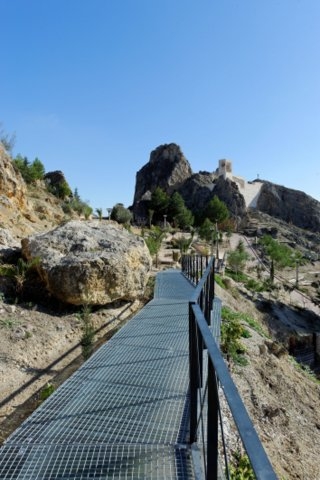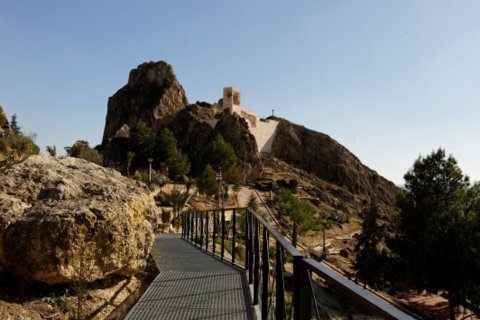

- EDITIONS:
 Spanish News Today
Spanish News Today
 Murcia Today
Murcia Today
 Alicante Today
Alicante Today
The Castillo de San Juan in Calasparra
The Castle of San Juan, Calasparra
The Castle of San Juan is located on the uppermost peak of the Serreta de San José, with the "casco antiguo" or old quarter of the town wrapped around the foot of the hill.
As with all of these medieval fortresses within the Region of Murcia its function was twofold: to protect the inhabitants from attack and to stamp the authority of the owner upon his lands.
This particular fortification was built during the 13th century, shortly after the Christian Reconquista of southern Spain, which had been in the hands of the Moors since the 7th century. (For further information visit the History of Calasparra or the History of the city of Murcia).

Even after the 13th century, Granada remained in the hands of the Moors, and although Murcia had surrendered peacefully in 1243 following the treaty of Alcáraz there were still frequent skirmishes along border territories and revolts within the remaining Moorish population. A major fortified Moorish settlement existed in Calasparra in the Villa Vieja, a few kilometres from the existing town, and although it is possible that the area was controlled from a fortification located on this site there is little to substantiate this theory, as the existing structure totally replaced any which formerly stood on the same location.
The Villa Vieja appears to have been abandoned following the Reconquista and the town of Calasparra was relocated to its current location by the Order of San Juan de Jerusalén, to whom it was given in 1289.  This important Military order was placed in charge of the town by Sancho IV of Castile and their rule lasted for 6 centuries.
This important Military order was placed in charge of the town by Sancho IV of Castile and their rule lasted for 6 centuries.
Medieval Spain was a place of turbulence as the Kingdoms of Aragón and Castile battled for supremacy, although eventually their intense rivalry was united in the desire to drive the Moorish forces out of Spain altogether. It would take nearly 200 years of struggle for this aim to be fulfilled, during which time the noble houses of Spain schemed and plotted, fought each other, and won and lost lands and power.
The Monarchy relied on the support of the stronger noble houses and religious Military Orders for its stability, support which was rewarded with land and power, although this was also a fine balancing act: some historians believe that Calasparra was given to the Order of San Juan simply as a means of limiting the power of the Order of Santiago, which owned large tracts of Murcia.
In Calasparra the Order was charged with repopulating the area with Christian settlers, and controlled all the important structures within the town, such as the mill and the bakery, as well as overseeing the wellbeing of the residents, educating the inhabitants and collecting revenue from the agricultural activity which took place in the fertile plains surrounding the town.
The Kingdom of Granada fell in 1492 to the Catholic forces of Isabella and Ferdinand, the Catholic Monarchs, following which the defensive role of the castle declined in importance. By the 17th century it was falling into disuse as the Order built structures within the old town.
Unfortunately, many of the walls had been built using a shuttering system favoured by the Moors, and these suffered most as the decline set in: most of the remains which have survived until today were instead built with stone blocks.
 A project was launched to restore and conserve as much of the original structure as possible, but the economic crisis of the early 21st century stalled restoration work. In the end the project This was finally completed in June 2014 and the restored castle was officially opened to the public.
A project was launched to restore and conserve as much of the original structure as possible, but the economic crisis of the early 21st century stalled restoration work. In the end the project This was finally completed in June 2014 and the restored castle was officially opened to the public.
The gardens below the castle have been improved to offer shaded seating and an impressive auditorium has been built alongside the historic structure, giving views across the surrounding countryside.
The castle can be visited at any time on foot , and is part of a walking route around the historic quarter of Calasparra. A leaflet for this route can be collected from the tourist office in the Edificio Casa Granero in Calasparra.

